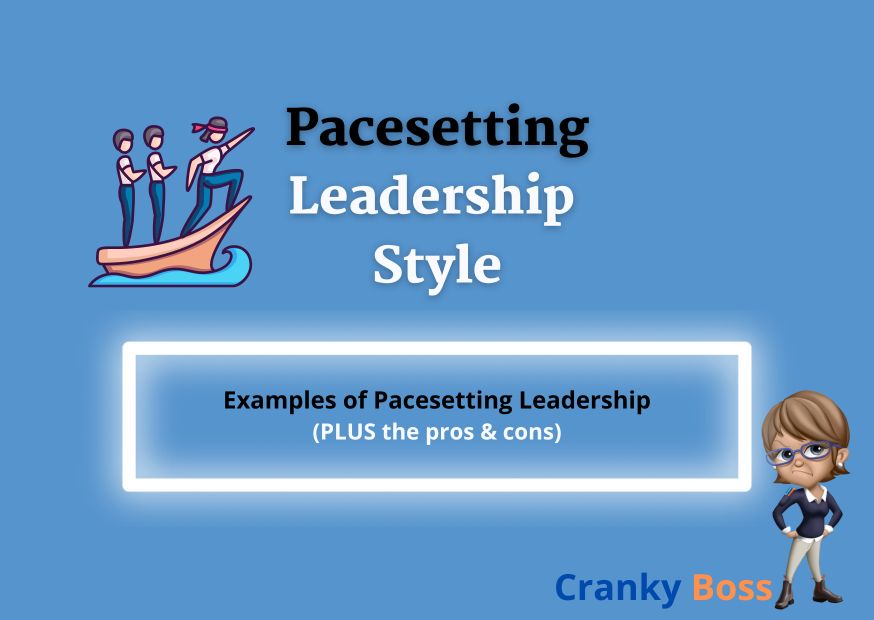Pacesetting leadership is a dynamic and demanding approach that emphasizes high standards and rapid results. Often seen in high-pressure environments, this leadership style can drive remarkable performance and swift goal achievement. However, it also comes with its own set of challenges, particularly regarding team morale and sustainability. Let’s take a look at what pacesetting leadership is, provide examples, and discuss its pros and cons.
What is Pacesetting Leadership?
Pacesetting leadership is a style where the leader sets high standards for performance and expects the team to meet these standards quickly and efficiently. This type of leader leads by example, working hard and demanding the same level of effort and performance from their team.
The term “pacesetting” comes from the idea of setting the pace in a race. The leader is the one in front, setting the speed and intensity for everyone else to follow.

This leadership style is very results-oriented and focuses on achieving goals and delivering high-quality work. Pacesetting leaders often have a clear vision of what needs to be accomplished and are highly motivated to achieve these goals. They are usually very skilled and experienced in their field, which allows them to set high expectations confidently. Pacesetting leadership is similar to transactional leadership in that both styles focus on performance and results.
What are Examples of Pacesetting Leadership?
Pacesetting leadership can be seen in various industries and situations. Here are a few examples:
- Technology Startups: In the fast-paced world of tech startups, a CEO who drives the team to innovate quickly and meet tight deadlines. They might push for the release of new products and updates at a rapid pace to stay ahead of competitors.
- Sales Teams: A sales manager who sets high targets for their team and expects them to achieve these targets within a short period. They might lead by example by making the most sales calls and closing the biggest deals.
- Sports Teams: A coach who demands peak performance from their athletes and sets rigorous training schedules. They might lead by demonstrating the level of effort and commitment required to win championships.
- Manufacturing: A plant manager who sets strict production goals and expects the team to meet high-quality standards consistently. They might be seen on the factory floor, ensuring everything runs smoothly and efficiently.
What are the Pros and Cons of Pacesetting Leadership?
Pros of Pacesetting Leadership
- High Performance: Pacesetting leaders often drive their teams to achieve high levels of performance. By setting ambitious goals and working hard themselves, they can inspire their team to do the same.
- Clear Expectations: Pacesetting leaders make their expectations clear. They can help team members understand what is required of them and strive to meet these standards.
- Role Modeling: By leading by example, pacesetting leaders can serve as role models for their team. They demonstrate the behaviours and work ethic needed to succeed.
- Rapid Achievement of Goals: Pacesetting leadership is highly effective in achieving goals quickly. This can be particularly beneficial in fast-paced industries or situations where time is of the essence. Examples include product launches or meeting critical deadlines.
- Improved Productivity: By setting high standards and pushing for excellence, pacesetting leaders can significantly boost the productivity of their team. Employees often rise to the challenge, completing tasks more efficiently and with higher quality.
- Enhanced Skill Development: Working under a pacesetting leader can help team members develop their soft and hard skills rapidly. The high expectations and the need to perform at peak levels can drive personal and professional growth.
- Clear Focus and Direction: Pacesetting leaders provide a clear focus and direction. This can help prevent confusion and ensure that everyone is aligned with the organization’s objectives. This clarity can lead to more cohesive and coordinated efforts.
- Competitive Advantage: In highly competitive markets, pacesetting leadership can give organizations an edge by consistently pushing the boundaries and striving for excellence. This can lead to innovations and improvements that set the company apart from its competitors.
Cons of Pacesetting Leadership
- High Stress & High Turnover Rates: The constant push for high performance and quick results can lead to high levels of stress and burnout among team members. This can result in decreased morale and higher turnover rates. Employers and leaders alike should always be on the look out for signs an employee is about to quit.
- Limited Creativity: The focus on results and quick performance can stifle creativity and innovation. Team members may not have the freedom to explore new ideas or approaches if they are constantly pressured to meet specific targets.
- Dependency on Leader: As with the disadvantage of transactional leadership Pacesetting leadership can create a dependency on the leader. If the leader is always setting the pace and driving performance, team members might struggle to perform well when the leader is not around.
- Risk of Burnout: The intense pressure to perform can lead to burnout among team members. The constant demand for high performance without adequate rest or support can result in physical and mental exhaustion.
- Limited Emotional Engagement: Pacesetting leaders often focus more on tasks and outcomes than on building emotional connections with their team. This can result in lower employee engagement and a weaker team dynamic.
- Potential for Micromanagement: Pacesetting leaders, in their drive for excellence, may fall into the trap of micromanaging their team. This can undermine the autonomy of team members and create a stifling work environment.
- Reduced Employee Morale: Constantly being pushed to meet high standards can lead to frustration and resentment among team members, particularly if their efforts are not recognized or rewarded. Furthermore this can negatively impact morale and overall job satisfaction.
When to Use Pacesetting Leadership
Pacesetting leadership is most effective in certain situations:
- Short-Term Projects: When quick results are needed, and the team is capable of meeting high standards, pacesetting leadership can be very effective. This might be the case in crisis situations or when a company is launching a new product.
- Highly Skilled Teams: Teams that are highly skilled and experienced might respond well to pacesetting leadership. These team members can meet the high standards set by the leader without requiring much guidance or support.
- Competitive Environments: In highly competitive environments, where quick and efficient performance is crucial, pacesetting leadership can help teams stay ahead of the competition.

How to Implement Pacesetting Leadership
If you think pacesetting leadership is suitable for your team, here are some tips on how to implement it effectively:
- Set Clear Goals: Clearly communicate the goals and standards you expect your team to meet. Make sure everyone understands what is required and the deadlines they need to meet.
- Lead by Example: Demonstrate the work ethic and performance you expect from your team. Show them what high performance looks like and how to achieve it.
- Provide Feedback: Regularly provide feedback on performance. Recognize and reward team members who meet or exceed expectations and offer constructive feedback to those who are struggling.
- Monitor Stress Levels: Keep an eye on the stress levels of your team. Ensure that the pressure to perform is not leading to burnout or negatively affecting morale. Offer support and resources to help team members manage stress.
- Be Flexible: While it’s important to maintain high standards, be flexible and understanding when team members face challenges. Offer support and adjust expectations if necessary to ensure the well-being of your team.
A Fascinating Fact About Pacesetting Leadership Style
A fascinating fact about pacesetting leadership is its origin in high-stakes environments, such as elite military units and competitive sports teams. In these settings, the need for rapid, high-quality performance and the ability to operate under intense pressure are critical.
Consequently, the pacesetting leadership style has been observed to significantly enhance performance and efficiency, with individuals being pushed to reach their peak potential quickly.
However, the sustainability of this style relies heavily on the exceptional resilience and motivation of the team members, thereby showcasing its dual nature of driving excellence while posing challenges to long-term well-being. This dual impact, therefore, highlights the importance of context and balance when applying pacesetting leadership in different environments.
Summing Up
Pacesetting leadership can be a powerful tool for driving high performance and achieving quick results. However, it is important to be aware of its potential downsides, such as high stress and low morale. By setting clear goals, leading by example, and monitoring the well-being of your team, you can effectively implement pacesetting leadership and achieve great results.

